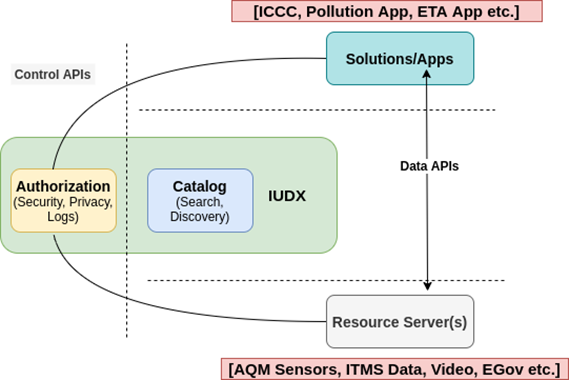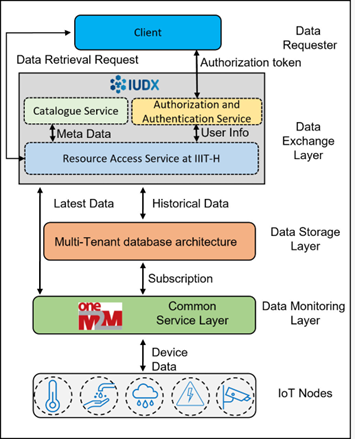In this interview, Vasanth Rajaraman of the IISc and Anuradha Vattem of the IIITH discuss their collaboration on an IoT application that combines India Urban Data Exchange (IUDX) and oneM2M platforms. This use-case focuses on a water metering scenario.
Q: Would you begin with some introductory information about yourselves?
VR: I am currently the Engineering Director of India Urban Data Exchange (IUDX), which aims to unleash the power of data for public good. My team and I are responsible for architecting, designing, developing, deploying, testing, and releasing IUDX as a scalable open-source data exchange platform. 
My interests lie in designing and developing performance-oriented highly scalable, available, and secure systems. I have over 12 years of experience in building scalable applications and cloud platforms. I hold a Bachelor's degree in Computer Science and Engineering from Anna University in Chennai, India. I also hold a Master of Science degree in Computer Science from Aalto University in Finland where I majored in mobile computing services and security. In the IoT domain, I have experience in developing products for the healthcare and smart city sectors.
 AV: I am presently the lead architect for the Smart City Research Center at the International Institute of Information Technology, Hyderabad (IIITH). Within the Center, we are building a Smart City Living Lab which includes a live testbed to deploy, test and generate smart city solutions.
AV: I am presently the lead architect for the Smart City Research Center at the International Institute of Information Technology, Hyderabad (IIITH). Within the Center, we are building a Smart City Living Lab which includes a live testbed to deploy, test and generate smart city solutions.
I started my career at ECIL, Hyderabad in 1990, and took on multiple roles in my career including as an engineer at a couple of US companies. I was the Vice President, R&D at Vrinda Technologies and the AGM of the Embedded Systems unit at Astra Microwave Products Limited.
Over my twenty-five year career, I have developed a rich industrial experience in design, development, implementation, analysis, and support of embedded systems. This includes applications in various domains like defence, space, industrial automation, and atomic energy. I have worked in India and USA, in industry and academia, and on systems that run underground to systems deployed in space.
Q: Please describe your institutions, especially for our international readers who might not be familiar with the Indian landscape.
AV: The IIIT-H is an autonomous university established in 1998. Over a short span of time of just over two decades, it has evolved strong research programmes in various areas with an emphasis on technology and applied research for industry and society. IIIT-H currently houses one of the largest AI research groups in the country.
Within the IIITH’s Smart City Research Centre, we have set up a Smart City Living Lab as an open-innovation ecosystem. This is a collaboration with two technology partners - the European Business and Technology Centre (EBTC) and the Amsterdam Innovation Arena (AIA). We are funded by the Ministry of Electronics and IT (MeitY) and also receive support from the Smart City mission and Government of Telangana. The campus is being transformed into a platform for learning, research, experimentation and for showcasing innovative ideas and approaches through the concept of Smart City Living Lab. The aim is to discover & develop cutting edge innovations with smart city use cases and to enrich them with the knowledge from our wider research activities.
VR: The IUDX Program Unit is part of the Society for Innovation and Development at the Indian Institute of Science (IISc) which is based in Bengaluru (Bangalore). IISc is one of India's leading institutes in the world in the area of science and technology research and higher education. IUDX was launched as an academic program at IISc. It has now evolved into a fully-fledged national initiative supported by the Ministry of Housing and Urban Affairs (MoHUA), Government of India.
The IUDX Program Unit is involved in developing and deploying the IUDX platform in several cities across India. At present 20 Indian smart cities benefit from our platform and we are working towards adding more cities to the list. We also actively engage with industry partners to develop various use cases of interest using the data on-boarded from cities where IUDX has been deployed.
We are also involved in several research and exploration activities such as Data Policy and Economics, and Data Privacy and Security. Under the Data Policy and Economics project, we are working on issues around public policy, data ownership for non-personal data and business models associated with the monetization of public data. Under our Data Privacy and Security project, we are exploring exciting and advanced techniques of privacy preserving computations such as Secure Enclaves, Secure multi-party compute and Differential Privacy.
Q: Would you tell us a bit more IUDX for people that might not be familiar with it?
VR: The IUDX Program is a pioneering initiative to enable the use of data for public good. It was born out of the need to facilitate data exchange by interconnecting the disparate and distributed data silos through a common set of sharing mechanisms. IUDX’s state-of-the-art, open-source software platform is a key tool in realising the vision of data-powered cities. It allows all forms of non-personal data to be shared in a controlled and secure fashion. That enables data providers to create innovative services and generate value. Currently we aim to support smart city administrations by facilitating the data exchange between various civic bodies, municipal departments, application developers and data consumers.
Our platform is now deployed in twenty smart cities in the country. We have been instrumental in enabling a wide variety of data-driven applications within Indian cities. In Pune, for example, we enabled a citizen safety application, using data about street conditions, lighting and crowds that was obtained through IUDX. In Surat, we enabled an application that provides accurate time of arrival and estimated occupancy for buses, using data on bus position, traffic conditions and ticket sales available through IUDX. A third example, from the holy city of Varanasi, uses data from garbage truck instrumentation, sensors on garbage bins and citizen input. These data sources are pulled through IUDX to deliver a powerful application that optimises solid waste pickup, reducing costs by 30%.
Over the next two years, twenty more smart cities will have IUDX platforms as their core digital infrastructure. In June last year, the Bureau of Indian Standards (BIS) adopted a standard for data exchange interfaces modelled after the IUDX API’s and this will become the recommendation for all Indian cities.
Q: IISc and IIITH recently collaborated on a water monitoring system. What did that involve?
AV: As part of the Living Lab, various IoT sensor nodes are deployed across the campus to monitor air quality, water quality, weather, energy parameters, and more. The data from these nodes are posted to a oneM2M server using a variety of network access technologies such as 4G, LoRaWAN and Wi-SUN for example. The goal is to use this data to make better decisions and deliver a better quality of life. Since our intention is to work across other verticals, sensor nodes are also deployed to collect water quality information and to quantify water supply and consumption patterns.
The data from various sensor nodes is primarily posted to oneM2M and archived in a data warehouse. As part of the IUDX/IIITH collaboration, we host an IUDX resource server (IUDX-RS). This allows us to make the data available to any IUDX registered user via IUDX APIs that interface to an IUDX-RS instance. We manage the interworking process by using data models that have been standardised for various verticals based on the interaction between IUDX and IIITH for the Smart City Living Lab. Data models enable a user to understand the parameters for sensor data and then use the data for analytics and application development purposes. Of course, there is an opportunity to provide this as a standard template for smart city implementation across India.
Prior to this collaboration, there was no framework for interfacing oneM2M with IUDX. Thanks to this collaboration, our pilot implementation provides a framework that designers can adapt for any similar smart city implementation with oneM2M.
Q: So, what did your teams implement and evaluate for the IUDX-oneM2M project?
VR: IUDX enables sharing of data without losing control. It allows data to be located and identified through a catalogue server. It also ensures that data consumers are authorised to access data in accordance with the data provider’s policies, as enforced through an authorization server. IUDX also ensures that data is transferred from provider to consumer in an understandable format through a resource server.

IUDX connects data sources to solution providers to enable full extraction of value
As illustrated, the IUDX technical architecture consists of a catalogue server which is used for resource discovery, an authorization server which helps in user and consent management and one or more resource servers which act as a data plane for publishing and consuming data. Out of the three components, IUDX has implemented the authorization service and the catalogue service as centralised servers. This allows the resource access services to operate in either centralised or distributed fashion. We helped the IIITH team to integrate their solution with IUDX by supporting them in the implementation of the Resource Access Service layer.
AV: The overall system for the pilot combines IUDX and oneM2M components. IIITH is responsible for the oneM2M element, which we decided to implement for the Smart City Living Lab because of its strong interoperability capabilities. We are working with the open-source OM2M common service layer which acts as the data monitoring layer and contains several Common Service Functions (CSFs) from the oneM2M standard.
As illustrated, live data that is received from different nodes for analysis through a live dashboard at the Smart City Living Lab. The data is stored in the Data Storage layer for long term storage and analysis.

Smart City Living Lab Architecture
The IUDX catalogue and authentication services in the data exchange layer are implemented as a centralised component and located in a public cloud infrastructure. This allows clients to register and discover resources, to understand the data models and data descriptors, to specify the usage policies and to obtain consent and access tokens.
The Resource Access Service interface is implemented as a distributed resource proxy layer and located within IIITH premises as an On Prem cloud solution. It connects with the data storage layer and the oneM2M-Data monitoring layer which correspond to Smart City Living Lab’s Data Lake. It uses standardised APIs (Application Programming Interface) to enable data exchange.
Every user needs to be registered as an IUDX user. They need to present a valid authorization token obtained from the IUDX Authentication and Authorization Service to obtain data from the Data Lake. The exchange layer checks for the authenticity of the user through a shared key between IUDX-IIITH. Once authenticated, the user can retrieve data through the APIs defined in the IUDX standard. The data flow from the node to the end user is structured to enable a smooth and reliable exchange of data.
Q: What capabilities can you demonstrate with the IUDX-oneM2M solution?
AV: We are able to develop applications once and deploy them in multiple instances by using standardised APIs and datasets. This reduces a lot of time taken to develop similar use cases in different places. In the context of the Indian market and smart city opportunities, the benefits of standardisation are obvious.
With consent-based data access, data protection is ensured as that allows only authorised clients to view the data. After authentication, any user sitting across any city in India can access the data. They also benefit from standardised datasets and standardised data models for various verticals that are included in the system. Having such data available would enable a user to get better insights and take any required actions in a timely manner.
Since a lot of data is available, visualisation adds value to generate insights and prediction. A dashboard can be created where one can compare and analyse data from multiple nodes and for different time intervals. In addition, it is also possible to create interactive dashboards and to control certain functions dynamically based on conditional requirements set by users. The combination of these capabilities with IoT data means that we can develop user-friendly dashboards and applications for a variety of use cases.
Q: What is the value of the IUDX-oneM2M combination?
VR: IUDX is designed to have a direct and positive impact on citizens' life. It will also help to transform India into a digitally empowered society and a knowledge economy.
There are several initiatives under the program that will ensure integrated growth across different aspects of urban development. We also expect that stakeholders such as government departments, city management/operations, system integrators, solution providers, software and application developers, other industry players, start-up, academia and, most importantly, citizens will benefit from the program.
Here are some examples of direct benefits to major stakeholders.
- City Administration can expect to:
- Reduce development cost and deploy solutions more quickly.
- Reduce the cost of operations through service delivery efficiency plus new sources of revenue
- Unleash innovation from industry ecosystem to solve city's problems at nominal cost
- Avoid vendor lock-in for their solutions and Apps
- Benefits to industry players, start-up firms and the App ecosystem include:
- Lower cost and higher speed of development due to open-source platform and standard APIs
- Improve portability for successful applications across cities and also globally
- In the case of academia and R&D organisations, the benefits include:
- More meaningful research and development by having direct access to a wide variety of data
- Opportunities to involve foreign institutions through access to unique data sets from India and to solve problems that are specific to Indian cities.
Q: What did your teams learn from this project and what advice would you offer to organisations looking at deploying IoT systems?
VR: You can think of our collaboration as an example of a large-scale IoT system. In the case of a smart city, this involves the production of huge amounts of data from a diverse set of sources. It also involves a wide range of data providers from various public and government establishments to private entities. A data exchange allows all of these actors and their data to interact.
Exchanging data via a centralised access service may lead to performance bottlenecks, data storage and scalability issues. Further, data providers may not want to route their data through external servers and would only want to serve data to the interested consumers directly. To enable efficient exchange of data in such scenarios, IUDX offers a federated data-access service architecture. This allows third party resource servers to coexist with other IUDX services. With our collaboration with IIITH around oneM2M technical standards, we defined and developed the architectural constructs involved in integrating an external resource server with existing IUDX systems.
Any organisation looking to develop large scale data driven applications should consider two points. One is standardised data access via APIs and the second is to use unified data model strategies to encourage application reuse and scalability.
AV: By 2050, cities will experience an inflow of 2.5 billion new urban dwellers which will drive demand for smart & sustainable development. Large populations will increase the burden on water, clean air, and energy resources. With the clever use of smart city practices and widespread deployment of IoT systems, the cities of tomorrow will be able to meet the demands of their residents in an effective and efficient way. IoT deployments are becoming widespread because of their utility, compactness, and cost effectiveness.
All of this makes it important to make deployments more reliable and safer by addressing critical issues such as sensor calibration, data model standardisation, and a standard framework to exchange data securely. As a lot of data is collected in this process, provision to archive data and make it available to the users through APIs will enable users to generate insights and smart solutions. These solutions can solve problems, increase the quality of life for a city’s residents, lower the consumption of resources and also generate a smaller carbon footprint.
An important lesson that everybody can learn is that “Smartness” is not just about installing digital interfaces in traditional infrastructure or streamlining city operations. It is also about using technology and data purposefully to make better decisions and deliver a better quality of life.
Q: How can our readers learn more about the project? Are there any resources they can access?
VR: Yes, here are some links to get started. The IUDX website is a good starting point and I would also point readers to our contributions to the Bureau of Indian Standards. Here is the link to the Unified Data Exchange Part 1 Architecture and to the Unified Data Exchange - Part 2 API Specifications.
AV: And from the IIIT-H perspective, here is the starting place for our Smart City Research Lab site and a series of blog posts on our activities.
Q: What plans do you have to build on this collaboration?
AV and VR: The concepts described above have been put to test in a real-world setting. The Smart City Living Lab at the IIITH in collaboration with IUDX, have developed, tested and productized the Distributed Resource Server after understanding the on-field constraints and challenges. With this effort we are one step ahead in having a Distributed Resource Server On Field.
Using the momentum built, we are expecting the following possibilities to extend the collaboration.
- Build Standardised Data and information models
- Expose datasets to application developers and academia
- Conduct hackathons and workshops for use case driven solution development
- Enable data monetization and marketplace
